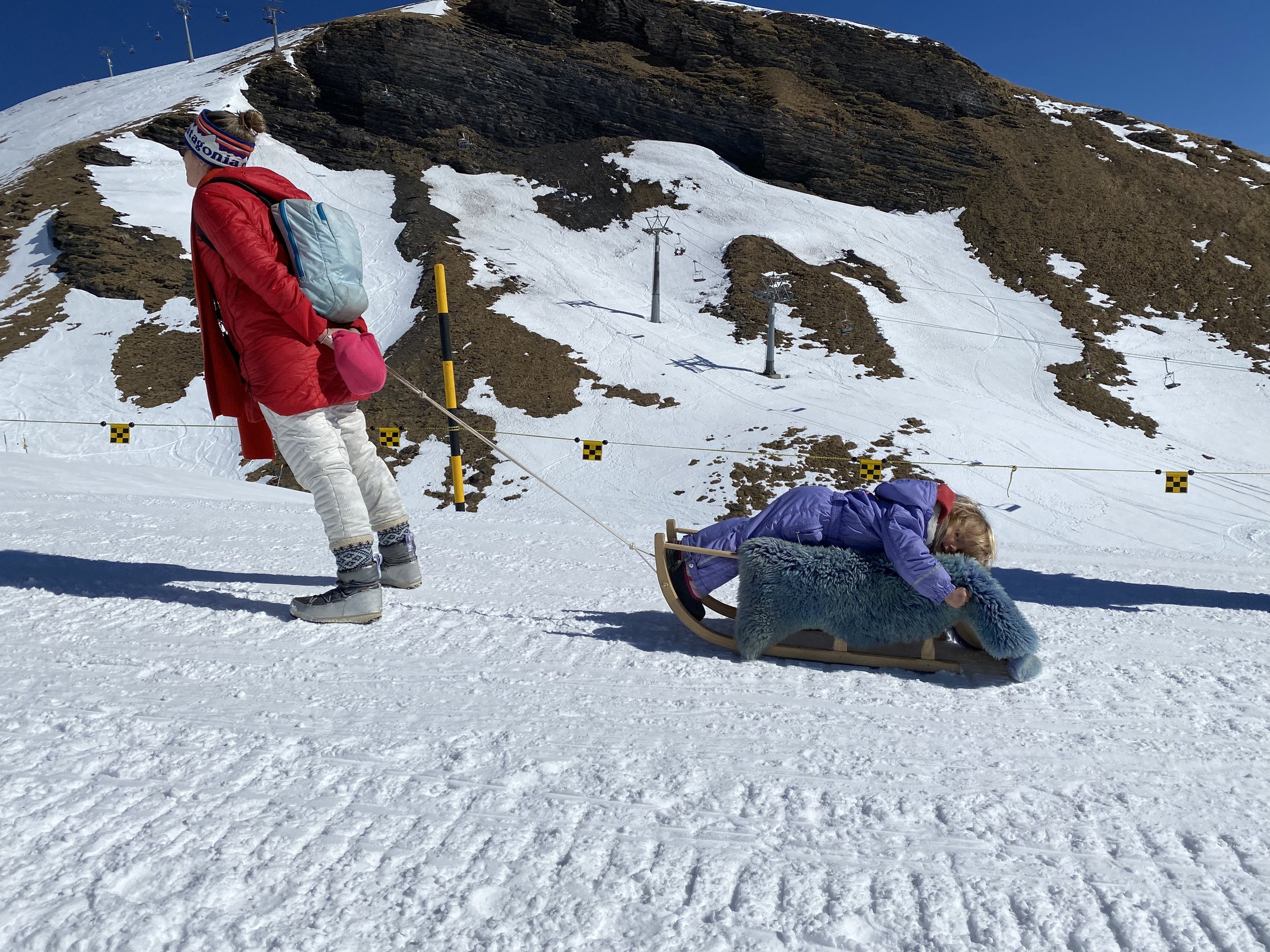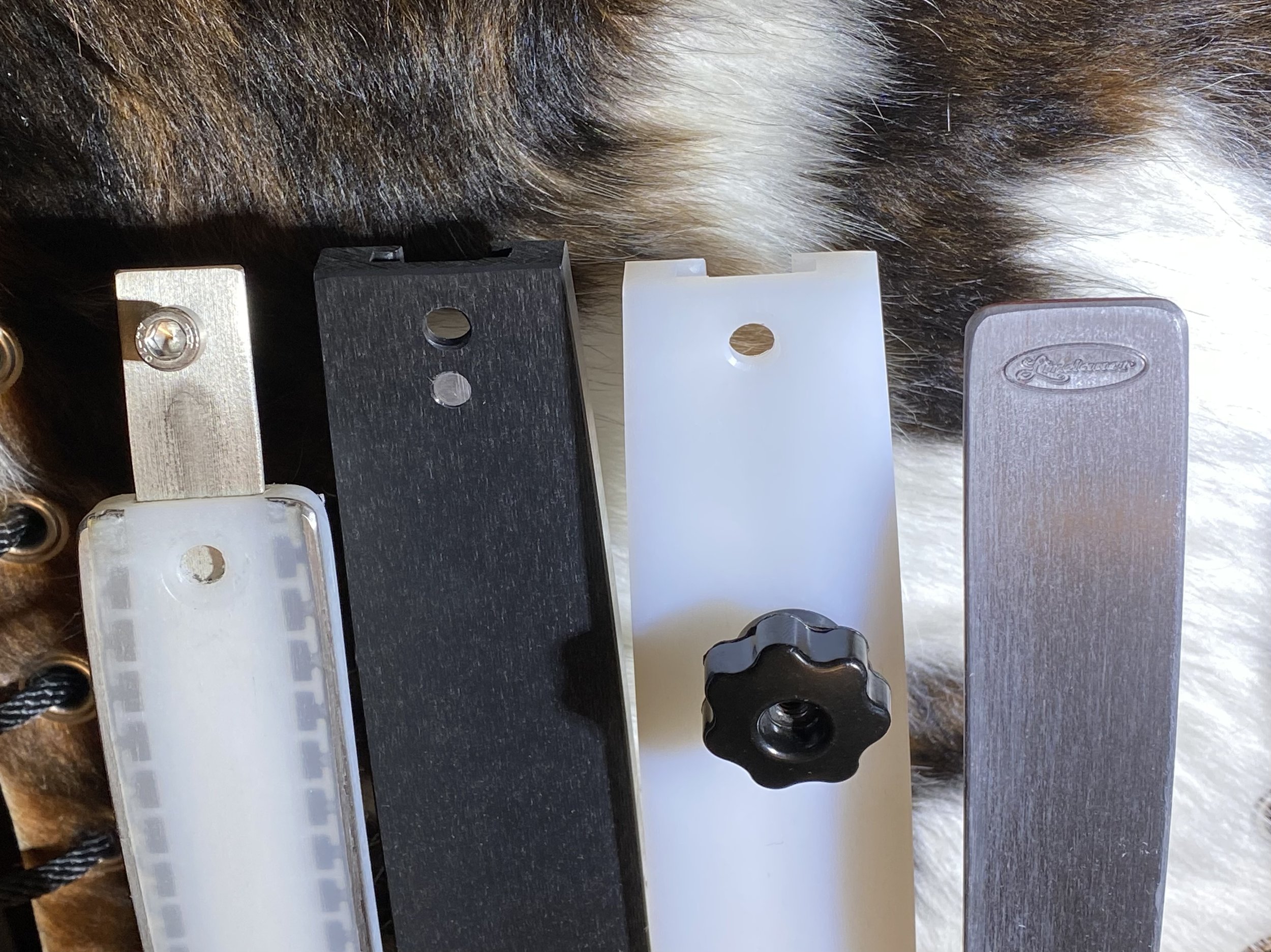Schlitten.
Rodel.
Same slope.
Different sled.

Swiss-German describes all sleds as schlitten. Strictly speaking, however, schlitten are the traditional, rigid, sleds that steer only by skidding one’s feet on the track.
Honestly, it’s impressive how many Euros you see out on a schlitten that looks like it originated with their great-great grandfather. They get a job done, no doubt, mostly if you need a place to chuck some firewood and a toddler - who will remember those rides for the rest of their life. You see people sledding in Europe old enough that you’d definitely worry about them driving.
Swiss sport rodelers set up for snow track racing. These guys absolutely smoked me on the Rinerhorn. Thrice. I have no excuse. I bounced off the berms and boards trying to keep up. Okay, it’s getting to me; I’ll make an excuse. It was -12C, I forgot my metal runners and was washing out the back end in every hard turn. These guys are still boss though.
A rodel, on the other hand, has flexible joints and rocker that introduce a precision turning action to the sled. Turns can be initiated most simply by just pulling the reins, or in a more advanced fashion by engaging your entire body. To stop, you basically just put your feet down and stand up. It gets a little more complicated than that, but not much. A sport rodel features recessed seating and steering horns to hug the sled and feather turns with the feet. They are fantastically responsive and comfortable to ride all day. Touring rodels are a utilitarian, budget-minded, option that will still get you down the Eiger in style.
In the last half decade, a bitter division has emerged between two mutually hostile camps: the old school touring rodelers of Tirol, and the modern snow rodelers of Switzerland. While the sled geometry was perfected on the ice, rodelhütte, and competition tracks of the East, but all the innovation is currently coming out of the snow tracks, legendary resorts, and freer riding conditions of the West. This new wave movement of big mountain sledding is led by such luminaries as Walter Jäger and Christian Bauer. The current boom in Swiss snow rodeling can be witnessed at locales such as Melchsee-Frutt, where rodelers at times appear to account for 30-40% of mountain users.
Derelict youth with touring rodels.
Sports model on a sport rodel. Mattie points out the shaped thigh recessions, low-profile cowhide seat and powder shield/puppy throne. Also highlighted are laminate construction, reversible knobbed reins, sculpted and padded steering horns, and interchangeable runner system. Overall an easy to control, highly responsive, and incredibly beautiful sled dog [not for sale].
An Ultimate Runner Setup
Lindauer 41mm metal-edged Concorde with steel retaining profile; 53mm “Ultra+Point”; 52mm White Convex; 31mm steel. Concordes represent a 32% increase in surface area over steel, the others a full 67%.
Three frame styles; from L to R:
Take note of the wood grain orientation on all these rodels; it’s the most important thing to check before you buy a wooden sled!
A Lindauer spline joint. Nobody else puts one of these on a sled; this is Gepetto-level showing off.
A Lindauer mitered finger joint. A few other top rodels employ this design.
A mortise and tenon joint, from a large Tirolean manufacturer. Most rodels employ this joint. This one looks particularly rough because it was produced with the wood grain improperly oriented, to save material, and broke. I had it repaired in the US with red oak and begged the carpenter, “I don’t care what it looks like, just make it solid.” It was perhaps an 8-hour fix; Gone are the days of being so desperate for sleds!

Factors to consider
-
Do you want something that will simply get you back down the hill in a civilized fashion, or do you want to get a little more athletic and carve turns? Slipping off a touring seat, and down the webbing reins, with nowhere to rest your feet, is a sub-par experience. Traditional metal runners are great for ice but too thin and sticky in snow. American snow conditions and geography demand composite runners and the ski resort rules only allow for proper sport rodels.
-
Aluminum is light and durable, but most rodels are wood. There are, however, two distinct categories of woodwork: factory and artisan. There’s no substitute for laminate and you don’t want to wait until you’re zip-tying and duct-taping a splintered strut to find out what a mortise and tenon joint is. Laminate is at least twice as strong as single beam and it’s very easy to look and a sled and see how it was made. Zoom in. You’ll also want to have a good look at the frame pieces. Honestly, European rodel conditions are like going to the park and most of their sleds don’t cut it in the US and won’t even be allowed at resorts.
-
Kufen (runner) angle: ranges from +/- 18º to 25º; from touring to sport/racing.
Reins: Webbing or cable. The stiffness of cable is necessary for switching turns fast and so they don’t fall to the ground if you lose them in a fast change. They are constructed with a rubber handle, metal knobs, and center ball for grip. Non-reversible reins make you look and feel pretty dumb when you stand up to walk away and can’t drag your sled like a boss.
Steering horns: A sport or racing rodel can be steered with the feet alone by feathering the sculpted horns. Hugging the entire sled, you gain comfort, position retention, and the ability to fine tune and force your turns.
Seating: A touring rodel seats you on the sled, a sport rodel in the sled; feels like the difference between riding a horse and driving a go-kart.
Runner material: Waxed steel is suitable for ice, a real pain in the ass, and doesn’t hold a candle to various composites or mini-skis (with metal edges) in any conditions other than ice. Skiers and dog sledders figured this out a long time ago.
Esthetic appeal and craftsmanship: There are aluminum sleds that serve a great purpose, but that purpose ain’t warming your heart just by sitting in the corner of the room, year-round.
-
Let’s face it: rodels currently come from Europe, are a heavy and awkward shape, energy is up, and shipping lanes are clogged. We’ve been hit for up to $500 but think the going rate should be down around $200-300. VAT is around 20%. Most Europeans won’t even respond to your email but here is a list and contact details for all manufacturers. They’re generally not incentivized to disassemble a sled to try to save you money when they are selling hundreds a year literally in a 100 miles radius. They want to put it in a box and hand it to FedEx, which ain’t gonna work for you. Max shipping size for a rodel should be about 48” x 18” x 6” (120 x 46 x 15 cm) and you should check that ahead of time. It’s a real hassle, we understand that, and irons are in the fire. Our shipping in the US ranges between $40-100, generally, for a disassembled sled.
-
If you’re still reading about it, there is an extremely high probability that you need at least one rodel. It’s sensationally fun and suitable for everybody in your family, forever. Check out our YouTube playlist European Sledding Scene for a taste of what you’re missing.





